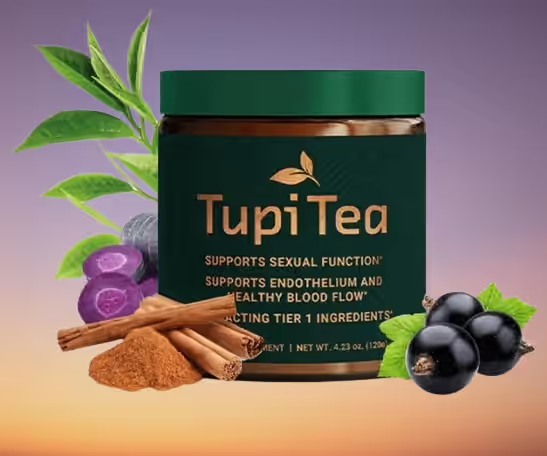Table of Contents
Thinking about natural ways to manage your blood pressure? You might have heard about hibiscus tea. It’s this bright red, tart drink that’s been used for ages, and there’s actually some interesting science behind why it might help. We’re going to look at how hibiscus tea to lower blood pressure works, how to drink it, and what you need to know before you start brewing a big batch. It’s not a magic cure, but it could be a nice addition to a healthy lifestyle.
Key Takeaways
- Regularly drinking hibiscus tea can help lower high blood pressure, thanks to its antioxidants that relax blood vessels.
- Aim for about three 8-ounce cups of hibiscus tea daily for noticeable effects on blood pressure, potentially over several weeks.
- Making hibiscus tea at home is simple: steep one tablespoon of dried hibiscus in boiling water for five minutes, then strain.
- While generally safe, avoid hibiscus tea if you are pregnant, have low blood pressure, or are taking blood pressure medication without consulting a doctor.
- Hibiscus tea offers other benefits like supporting liver health and providing antioxidants, but always check with a healthcare provider if you have existing conditions or are on medication.
Understanding Hibiscus Tea’s Impact on Blood Pressure
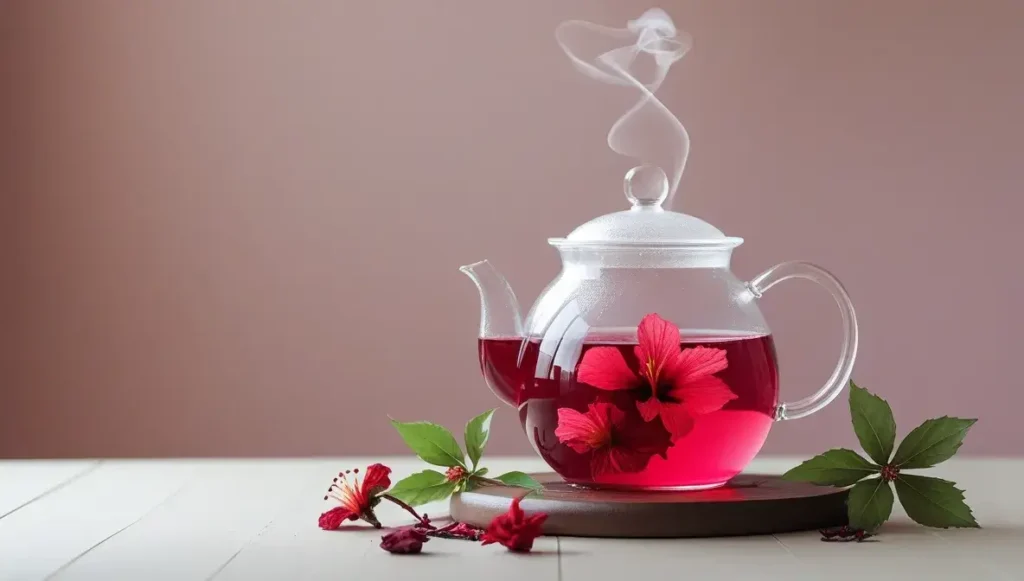
So, you’re curious about how this vibrant, tart tea might help with your blood pressure, right? It’s not just a pretty drink; there’s some real science behind why hibiscus tea for hypertension is gaining attention. Many people are looking for natural ways to manage their health, and this herbal tea is definitely one to consider. It’s all about how hibiscus interacts with your body to promote better cardiovascular health.
Basically, hibiscus tea works by helping your blood vessels relax. The magic comes from compounds like anthocyanins and other antioxidants found in the hibiscus flower. These compounds are thought to encourage your body to produce more nitric oxide. Nitric oxide is a gas that signals your blood vessels to widen, which in turn reduces the resistance blood faces as it flows. Less resistance means lower pressure. It’s a pretty neat natural process that can contribute to drinking hibiscus to manage BP.
The Role of Antioxidants in Blood Vessel Health
Think of antioxidants as tiny protectors for your cells. In hibiscus tea, these powerful compounds combat something called oxidative stress, which can damage your blood vessels over time. By neutralizing harmful free radicals, antioxidants help keep your blood vessels healthy and flexible. This flexibility is key for good circulation and maintaining a healthy blood pressure. The benefits of hibiscus for heart health are strongly linked to this protective action.
Scientific Evidence Supporting Hibiscus Tea for Hypertension
There’s a growing body of research looking into hibiscus tea for hypertension. Some studies have shown that regularly drinking hibiscus tea can lead to a noticeable drop in both systolic and diastolic blood pressure. For instance, one review of several studies indicated that hibiscus tea could lower systolic pressure by about 7.58 mmHg and diastolic pressure by around 3.53 mmHg on average. While it’s not a magic bullet, it shows promise as a complementary approach to lowering blood pressure with herbal tea. Animal studies also suggest potential benefits in managing hypertension [efca].
- Relaxed Blood Vessels: Promotes wider blood vessels, easing blood flow.
- Reduced Resistance: Lowers the pressure against artery walls.
- Antioxidant Protection: Shields blood vessels from damage.
While hibiscus tea shows promise for managing blood pressure, it’s important to remember it’s a natural remedy. It works best as part of a healthy lifestyle and should be discussed with a healthcare provider, especially if you’re on medication.
Optimal Consumption for Blood Pressure Management
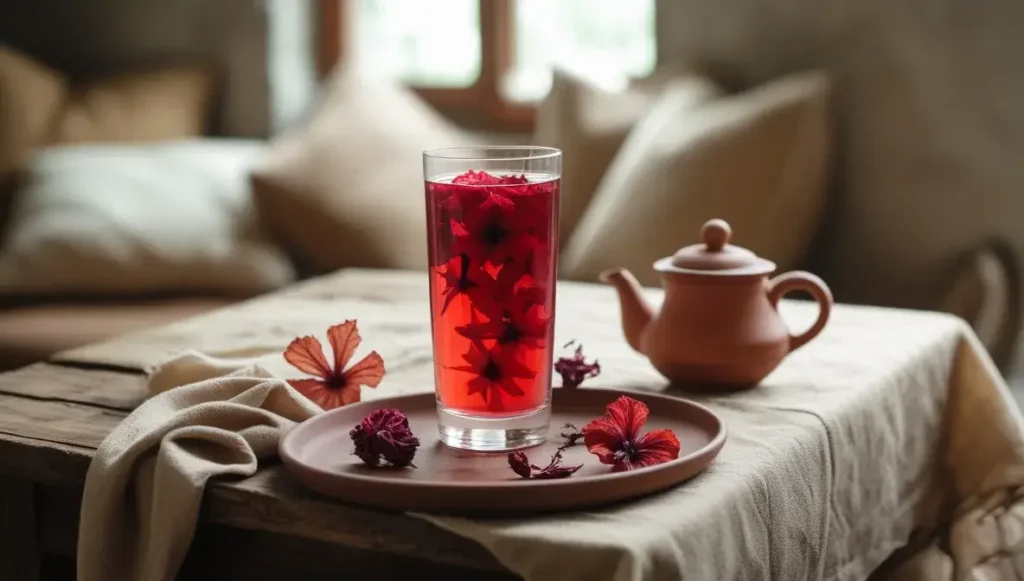
So, you’ve heard that hibiscus tea might be a good idea for keeping your blood pressure in check. That’s great! But like anything you add to your routine, especially when you’re trying to manage your health, knowing how much and how often to drink it makes a big difference. It’s not just about grabbing any hibiscus tea; it’s about using it wisely.
Recommended Daily Intake of Hibiscus Tea
When it comes to hibiscus tea and blood pressure, consistency is key. Most studies that show positive results use a pretty specific amount. Think about two standard cups a day. Each cup is typically made with about 1.25 grams of dried hibiscus flowers steeped in water. It’s not a huge amount, but it’s enough to potentially make a difference over time. Drinking this amount regularly seems to be the sweet spot for many people looking for natural ways to reduce blood pressure. It’s a simple addition to your day, maybe one in the morning and one in the afternoon, that can fit into most lifestyles.
Duration of Consumption for Noticeable Effects
Don’t expect miracles overnight. When you’re looking at natural remedies for high blood pressure, patience is a virtue. Studies often show that it takes about a month of consistent daily consumption to start seeing noticeable changes in blood pressure readings. Some people might notice effects sooner, while others might need a bit longer. It’s all part of finding what works for your body. Remember, this is about long-term management, not a quick fix for managing systolic pressure with beverages.
Frequency of Drinking Hibiscus Tea for Best Results
To get the most out of hibiscus tea for lowering diastolic pressure with herbs, aim for daily consumption. Drinking it once a day is a good start, but two cups daily, as mentioned, appears to be more effective based on research. Spreading it out, like having one cup in the morning and another in the evening, can help maintain a more consistent level of the beneficial compounds in your system. It’s one of the more accessible natural ways to reduce hypertension, but like any herbal approach, it works best when it’s a regular part of your day.
It’s important to remember that while hibiscus tea can be a helpful part of a broader strategy for managing blood pressure, it’s not a standalone cure. Combining it with a healthy diet, regular exercise, and other lifestyle changes recommended by your doctor will give you the best chance of success. Think of it as a supportive beverage in your overall wellness plan.
Here’s a quick rundown of what to aim for:
- Daily Consumption: Make it a habit, not an occasional drink.
- Amount: Around 2 cups (approx. 480 mL total) per day.
- Duration: Give it at least one month to see potential effects.
- Timing: Spread your intake throughout the day if possible.
👉 Experience the Ultimate Premium Hibiscus Tea for Superior Wellness 👈
Preparing Hibiscus Tea at Home
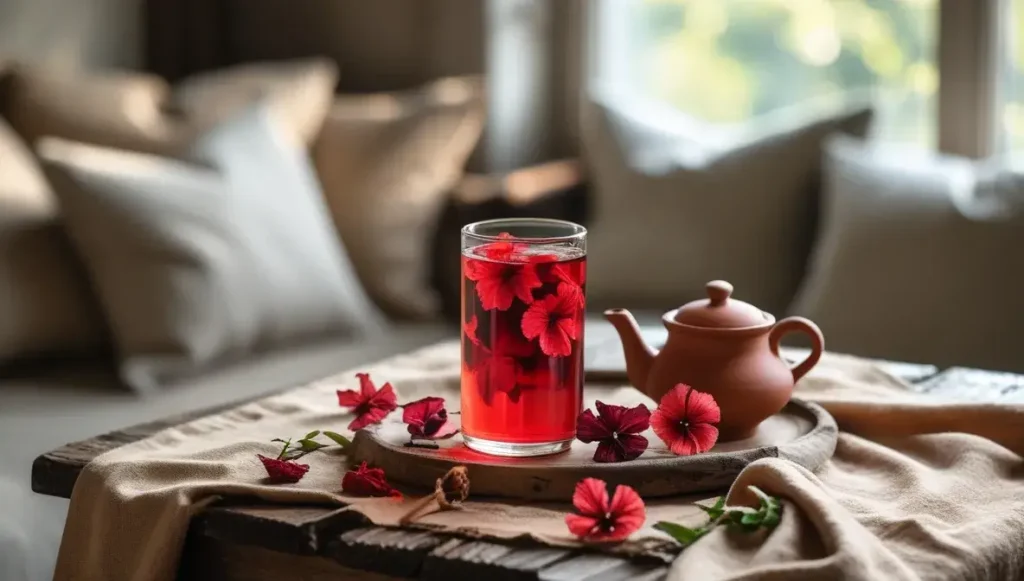
Making your own hibiscus tea is surprisingly simple, and it’s a great way to control the ingredients and flavor. You don’t need fancy equipment, just a few basic things you probably already have in your kitchen. It’s a nice change of pace from just grabbing a pre-made tea bag.
Simple Recipe for Hibiscus Tea
This is a straightforward way to get started. You’ll find that the tartness is quite refreshing, but don’t worry, we’ll talk about how to adjust it.
Here’s what you’ll need:
- 1 teaspoon of dried hibiscus flowers (or about 1-2 hibiscus tea bags)
- 8 ounces of boiling water
Instructions:
- Place the dried hibiscus flowers or tea bag into your mug or teapot.
- Pour the boiling water over the hibiscus.
- Let it steep for about 5 minutes. If you like a stronger flavor, you can let it go a bit longer, but be careful not to over-steep, which can make it too bitter.
- Strain out the flowers if you used loose ones, or remove the tea bag.
- Let it cool to your preferred drinking temperature.
Steeping Time and Water Temperature
The temperature of your water and how long you let the hibiscus steep really make a difference in the final taste. Using boiling water helps to extract all those good compounds from the flowers. For steeping, 5 minutes is a good starting point. If you’re using a stronger variety of hibiscus or want a more intense flavor, you might extend this slightly. However, steeping for too long, say over 10-15 minutes, can sometimes bring out a more bitter taste, which isn’t always what you want, especially if you’re trying to enjoy it regularly.
Enjoying Hibiscus Tea Hot or Cold
One of the best things about hibiscus tea is its versatility. It’s delicious served hot, especially on a chilly day. The warm infusion can be quite comforting. But if you prefer something cooler, especially during warmer months, it’s fantastic as iced tea. Just brew it as usual, let it cool down, and then pour it over ice. You can even make a larger batch and keep it in the refrigerator for a few days. Some people like to add a splash of fruit juice, like pomegranate, or a bit of natural sweetener to cut through the tartness, which is quite pronounced, similar to cranberries. It’s all about finding what tastes best to you.
Remember, while hibiscus tea is generally safe, it’s always a good idea to chat with your doctor before making it a daily habit, especially if you’re on medication or have any health conditions. They can give you the best advice for your personal situation.
Important Considerations and Precautions
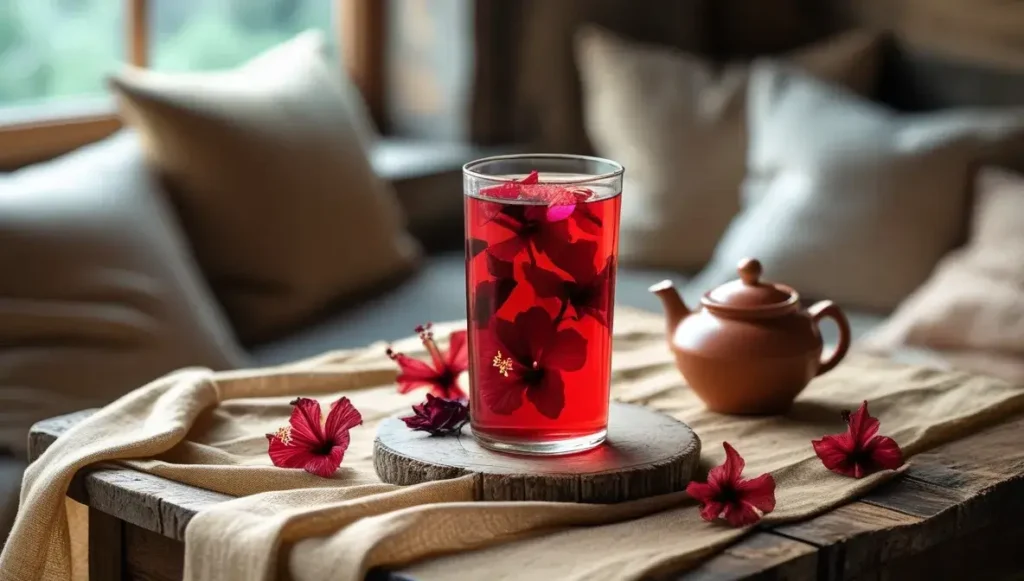
While hibiscus tea is generally safe for most people and can be a pleasant addition to a heart-healthy lifestyle, it’s not a one-size-fits-all solution. There are a few things to keep in mind before you start brewing up a storm.
Who Should Avoid Hibiscus Tea?
While many can enjoy hibiscus tea, some individuals should be cautious or steer clear altogether. If you have any underlying health conditions, it’s always a good idea to chat with your doctor first. Generally, people with the following conditions might want to limit or avoid hibiscus tea:
- Low Blood Pressure (Hypotension): Hibiscus tea is known for its blood pressure-lowering effects. If your blood pressure is already on the lower side, drinking hibiscus tea could potentially make it drop too much, leading to dizziness or fainting.
- Certain Liver Conditions: Some research suggests that very high doses of hibiscus extract might affect the liver. While typical tea consumption is unlikely to cause issues, if you have a pre-existing liver problem, it’s best to consult your healthcare provider.
- Diuretic Medication Users: Hibiscus tea has mild diuretic properties, meaning it can increase urine production. If you’re already taking diuretic medications, combining them with hibiscus tea could potentially lead to dehydration or electrolyte imbalances.
Potential Interactions with Medications
This is a big one. Hibiscus tea can interact with certain medications, and it’s super important to be aware of this. Always talk to your doctor or pharmacist if you’re taking any prescription drugs before making hibiscus tea a regular part of your routine.
Here are a few common areas where interactions might occur:
- Diuretics: As mentioned, hibiscus can amplify the effects of diuretic drugs, potentially leading to dehydration.
- Blood Pressure Medications: If you’re already on medication to lower your blood pressure, adding hibiscus tea could cause your blood pressure to drop too low. This could lead to symptoms like dizziness, lightheadedness, or even fainting.
- Acetaminophen (Tylenol): Some studies suggest hibiscus might affect how the body processes acetaminophen, though the clinical significance for typical tea consumption is still being researched.
- Antimalarial Drugs: There’s some evidence that hibiscus might interfere with the effectiveness of certain antimalarial medications. If you’re taking these, definitely check with your doctor.
Risks for Pregnant Individuals and Those with Hypotension
This section deserves a bit more focus because it involves specific groups who need to be extra careful.
For pregnant individuals, hibiscus tea is generally not recommended. While some traditional uses suggest it might help with labor, there’s not enough solid scientific evidence to support its safety during pregnancy. It’s always best to err on the side of caution and stick to beverages with well-established safety profiles when you’re expecting. Similarly, if you’re someone who naturally has low blood pressure, or if you’ve been diagnosed with hypotension, you’ll want to be very mindful of hibiscus tea’s potent effect on blood pressure. It’s not worth the risk of feeling unwell or experiencing more serious symptoms just for a cup of tea.
Remember, while hibiscus tea offers potential benefits, it’s just one piece of the puzzle when it comes to managing blood pressure. Lifestyle changes, a balanced diet, and regular medical check-ups are still the cornerstones of good health.
👉 Unlock Revolutionary Health Benefits with Exclusive Hibiscus Tea 👈
Hibiscus Tea Beyond Blood Pressure Benefits
While we’ve focused a lot on how hibiscus tea can help manage blood pressure, this vibrant drink offers a whole lot more for your well-being. It’s not just about your heart; this herbal tea is packed with good stuff that can support your body in several other ways. Think of it as a little cup of wellness that goes the extra mile.
Nutritional Profile of Hibiscus Tea
Hibiscus tea is surprisingly rich in nutrients. It’s a good source of Vitamin C, which is great for your immune system, and also contains minerals like calcium and zinc. But where it really shines is in its antioxidant content. These compounds, like anthocyanins and flavonoids, are what give the tea its beautiful red color and are key players in protecting your cells from damage. In fact, some research suggests hibiscus tea might even pack more antioxidants than green tea, which is pretty impressive!
Support for Liver Function and Metabolic Health
Beyond its cardiovascular perks, hibiscus tea shows promise in supporting your liver and metabolic health. Studies suggest that the compounds in hibiscus can help your liver process fats more efficiently, potentially reducing the risk of fatty liver disease. It might also play a role in managing blood sugar levels and improving cholesterol profiles, contributing to overall metabolic balance. This makes the benefits of hibiscus drink extend to a broader sense of health.
Antimicrobial Properties of Hibiscus
Interestingly, hibiscus tea has also been traditionally used for its ability to combat certain infections. The high antioxidant levels are thought to contribute to its antimicrobial properties, meaning it may help fight off some bacteria and fungi. While it’s not a replacement for medical treatment, this natural ability adds another layer to the hibiscus benefits for heart health and overall resilience.
It’s amazing how a simple herbal tea can offer so many different advantages. From protecting your cells to supporting vital organs, the herbal remedies for high blood pressure like hibiscus tea are truly remarkable. It’s a testament to the power of nature in supporting our health goals, making drinking tea for blood pressure management a more holistic choice.
Here’s a quick look at what makes hibiscus tea so special:
- Rich in Antioxidants: Helps protect your body from cell damage.
- Supports Liver Health: Aids in fat metabolism and may reduce fatty liver risk.
- Metabolic Benefits: May help with blood sugar and cholesterol balance.
- Antimicrobial Action: Shows potential in fighting certain bacteria and fungi.
These additional benefits of hibiscus flower tea make it a fantastic addition to a healthy lifestyle, complementing its well-known role in herbal tea for heart health.
Choosing the Right Hibiscus for Your Tea
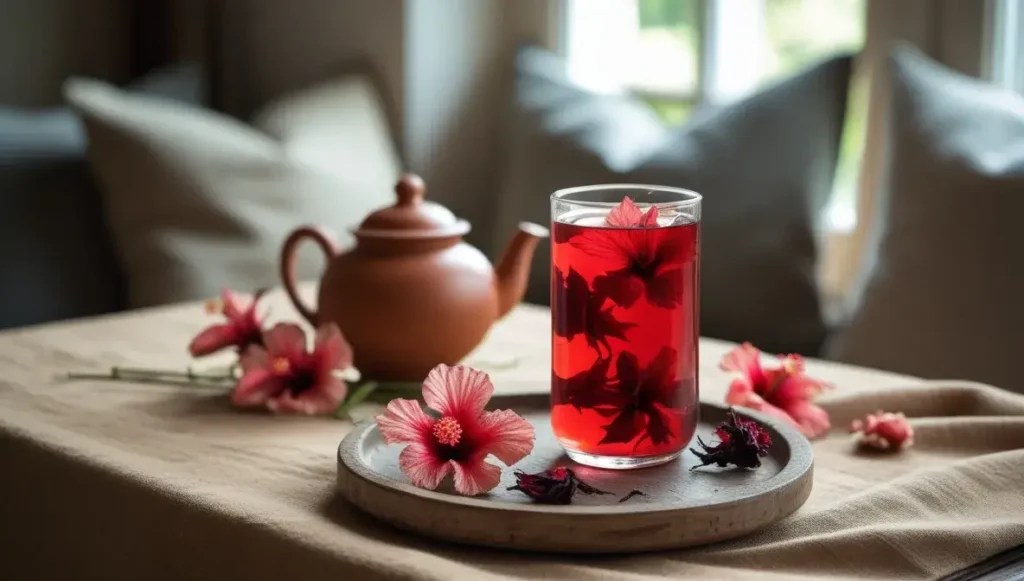
When you’re looking to brew up some hibiscus tea, especially for its potential health perks like managing blood pressure, not all hibiscus plants are created equal. It’s a bit like picking the right apple for baking versus eating raw; you want the one that does the job best.
So, you’ve heard about hibiscus tea and its benefits, maybe even its ability to help with blood pressure. That’s great! But here’s a little detail that often gets overlooked: the type of hibiscus you use really matters. Think of it like choosing ingredients for a recipe – the quality and type of ingredient can totally change the outcome.
Understanding Different Hibiscus Varieties
There are literally hundreds of types of hibiscus out there. You see them in gardens everywhere, with those big, showy flowers. Many of these are grown for their looks, not necessarily for brewing into a tea. They might be pretty, but they don’t usually pack the same punch when it comes to the compounds that give hibiscus tea its health benefits.
The Importance of Hibiscus Sabdariffa
When people talk about hibiscus tea for health, they’re almost always referring to a specific kind: Hibiscus sabdariffa. This is the variety that’s been studied for its potential to lower blood pressure and cholesterol. Other types, like Hibiscus rosasinensis, might be more common in ornamental gardens or even some commercial teas, but the scientific backing for their health benefits, particularly for blood pressure, isn’t as strong. So, if you’re brewing for a purpose, look for Hibiscus sabdariffa.
Quality Considerations for Commercial Teas
When you’re buying hibiscus tea, whether it’s loose leaf or in tea bags, check the packaging. You want to see Hibiscus sabdariffa listed as the main ingredient. Sometimes, brands might mix it with other herbs or flowers, which is fine, but make sure the hibiscus part is the right kind. The color of the dried hibiscus can also be a good indicator – it should be a deep, rich red. If it looks faded or dull, it might not be the freshest or highest quality.
Here’s a quick rundown:
- Look for Hibiscus sabdariffa: This is the key variety for blood pressure benefits.
- Deep Red Color: A good sign of quality and potency.
- Check Ingredients: Ensure it’s primarily Hibiscus sabdariffa if you’re seeking specific health outcomes.
Using the right type of hibiscus is more than just a detail; it’s the foundation for getting the benefits you’re looking for. It’s worth taking a moment to check the label or source your dried hibiscus carefully.
Hibiscus Tea to Lower Blood Pressure: The Final Takeaway
Alright, so we’ve talked a lot about hibiscus tea and how it might help with blood pressure. It seems like a pretty neat natural option for some folks. Remember, drinking a few cups a day for a few weeks might make a difference. But, and this is a big but, it’s not a magic fix. If you’re on blood pressure meds, or if you have other health stuff going on, you really need to chat with your doctor first.
They can tell you if it’s a good idea for you. For most people, though, enjoying a warm cup of this tart, tasty tea could be a nice little addition to a healthy lifestyle. Just don’t forget to check in with your healthcare provider to be safe.
👉 Refresh Your Day with the Top-Rated Premium Hibiscus Tea 👈
Frequently Asked Questions
Can drinking hibiscus tea really help lower my blood pressure?
Yes, studies show that sipping on hibiscus tea regularly can be quite helpful for bringing down high blood pressure. It’s packed with natural stuff called antioxidants that help your blood vessels relax, making it easier for blood to flow and lowering pressure.
How much hibiscus tea should I drink each day for it to work?
To see a difference in your blood pressure, many experts suggest drinking about three cups of hibiscus tea every day. It might take a few weeks, maybe even up to two months, of drinking it regularly to notice the effects.
How do I make hibiscus tea at home?
Making your own hibiscus tea is super simple! Just take about a tablespoon of dried hibiscus flowers and steep them in a cup of boiling water for about five minutes. Then, strain out the flowers, and you can drink it warm or chill it for iced tea.
Are there any people who shouldn’t drink hibiscus tea?
Generally, hibiscus tea is safe for most adults, and it doesn’t have caffeine. However, if you’re pregnant, it’s best to avoid it. Also, if you tend to have low blood pressure, you should be careful, as it might lower it even more.
Can I drink hibiscus tea if I’m already taking blood pressure medicine?
It’s usually not a good idea to mix hibiscus tea with blood pressure medication. Hibiscus tea can lower blood pressure on its own, and combining it with medicine could cause your blood pressure to drop too much, which can be dangerous.
Besides blood pressure, what else is hibiscus tea good for?
Hibiscus tea is loaded with vitamins and antioxidants, which are great for your overall health. It might also help with things like supporting your liver, improving digestion, and even fighting off certain germs.
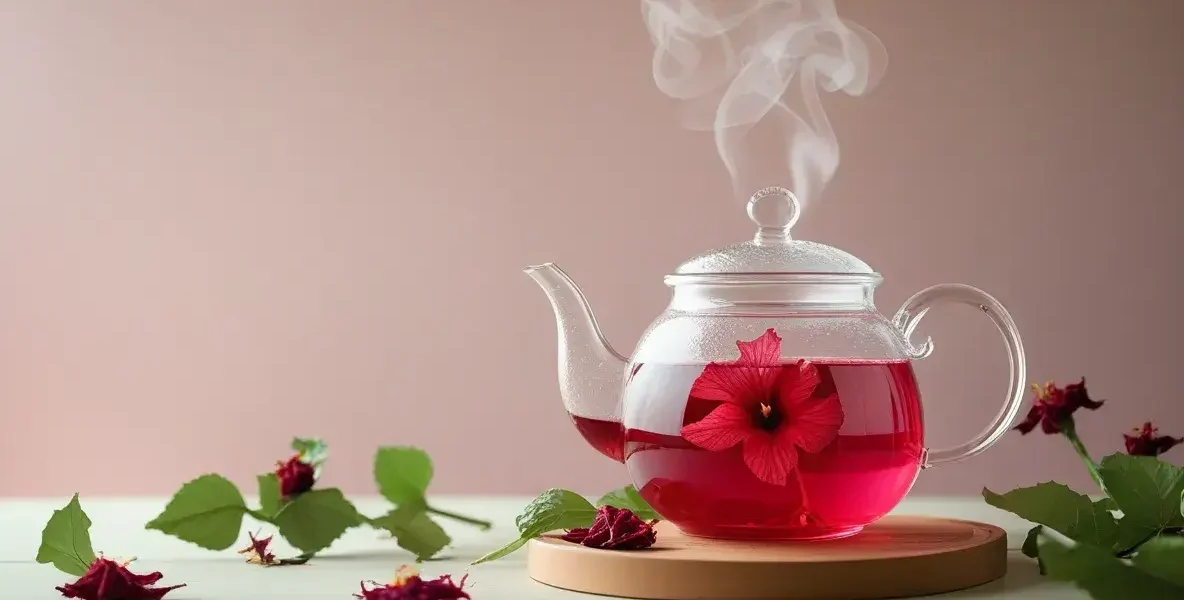







![Jasmine Tea vs Green Tea Benefits: Which Gives Better Health Results? [2025] jasmine tea vs green tea benefits](https://www.goteaworld.com/wp-content/uploads/2025/09/jasmine-tea-vs-green-tea-benefits-150x150.webp)




